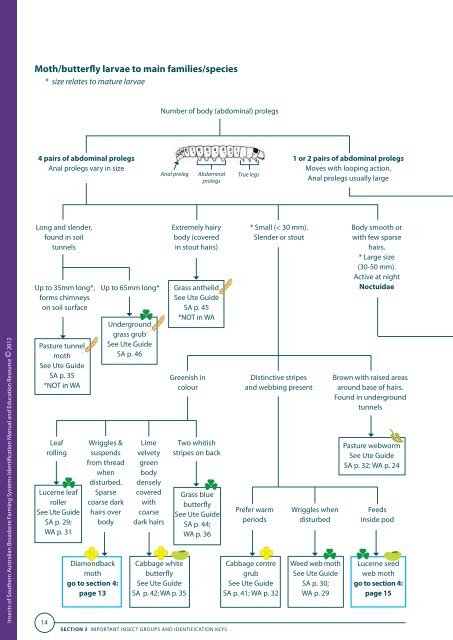Insects of Southern Australian Broadacre Farming Systems - Grains ...
Insects of Southern Australian Broadacre Farming Systems - Grains ...
Insects of Southern Australian Broadacre Farming Systems - Grains ...
You also want an ePaper? Increase the reach of your titles
YUMPU automatically turns print PDFs into web optimized ePapers that Google loves.
Moth/butterfly larvae to main families/species<br />
* size relates to mature larvae<br />
Number <strong>of</strong> body (abdominal) prolegs<br />
4 pairs <strong>of</strong> abdominal prolegs<br />
Anal prolegs vary in size<br />
Anal proleg<br />
Abdominal<br />
prolegs<br />
True legs<br />
1 or 2 pairs <strong>of</strong> abdominal prolegs<br />
Moves with looping action.<br />
Anal prolegs usually large<br />
<strong>Insects</strong> <strong>of</strong> <strong>Southern</strong> <strong>Australian</strong> <strong>Broadacre</strong> <strong>Farming</strong> <strong>Systems</strong> Identification Manual and Education Resource © 2012<br />
Long and slender,<br />
found in soil<br />
tunnels<br />
Up to 35mm long*,<br />
forms chimneys<br />
on soil surface<br />
Pasture tunnel<br />
moth<br />
See Ute Guide<br />
SA p. 35<br />
*NOT in WA<br />
14<br />
Leaf<br />
rolling<br />
Lucerne leaf<br />
roller<br />
See Ute Guide<br />
SA p. 29;<br />
WA p. 31<br />
Diamondback<br />
moth<br />
go to section 4:<br />
page 13<br />
Up to 65mm long*<br />
Underground<br />
grass grub<br />
See Ute Guide<br />
SA p. 46<br />
Wriggles &<br />
suspends<br />
from thread<br />
when<br />
disturbed.<br />
Sparse<br />
coarse dark<br />
hairs over<br />
body<br />
Lime<br />
velvety<br />
green<br />
body<br />
densely<br />
covered<br />
with<br />
coarse<br />
dark hairs<br />
Extremely hairy<br />
body (covered<br />
in stout hairs)<br />
Grass anthelid<br />
See Ute Guide<br />
SA p. 45<br />
*NOT in WA<br />
Greenish in<br />
colour<br />
Cabbage white<br />
butterfly<br />
See Ute Guide<br />
SA p. 42; WA p. 35<br />
Two whitish<br />
stripes on back<br />
Grass blue<br />
butterfly<br />
See Ute Guide<br />
SA p. 44;<br />
WA p. 36<br />
SECTION 3 IMPORTANT INSECT GROUPS AND IDENTIFICATION KEYS<br />
* Small (< 30 mm).<br />
Slender or stout<br />
Distinctive stripes<br />
and webbing present<br />
Prefer warm<br />
periods<br />
Cabbage centre<br />
grub<br />
See Ute Guide<br />
SA p. 41; WA p. 32<br />
Wriggles when<br />
disturbed<br />
Weed web moth<br />
See Ute Guide<br />
SA p. 30;<br />
WA p. 29<br />
Body smooth or<br />
with few sparse<br />
hairs.<br />
* Large size<br />
(30-50 mm).<br />
Active at night<br />
Noctuidae<br />
Brown with raised areas<br />
around base <strong>of</strong> hairs.<br />
Found in underground<br />
tunnels<br />
Pasture webworm<br />
See Ute Guide<br />
SA p. 32; WA p. 24<br />
Feeds<br />
inside pod<br />
Lucerne seed<br />
web moth<br />
go to section 4:<br />
page 15

















